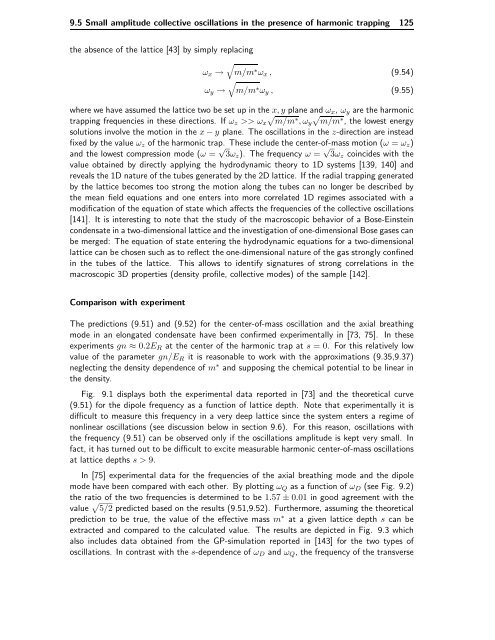Bose-Einstein Condensates in Rotating Traps and Optical ... - BEC
Bose-Einstein Condensates in Rotating Traps and Optical ... - BEC
Bose-Einstein Condensates in Rotating Traps and Optical ... - BEC
Create successful ePaper yourself
Turn your PDF publications into a flip-book with our unique Google optimized e-Paper software.
9.5 Small amplitude collective oscillations <strong>in</strong> the presence of harmonic trapp<strong>in</strong>g 125<br />
the absence of the lattice [43] by simply replac<strong>in</strong>g<br />
<br />
ωx → m/m∗ωx ,<br />
<br />
(9.54)<br />
ωy → m/m∗ωy , (9.55)<br />
where we have assumed the lattice two be set up <strong>in</strong> the x, y plane <strong>and</strong> ωx, ωy <br />
are the harmonic<br />
trapp<strong>in</strong>g frequencies <strong>in</strong> these directions. If ωz >> ωx m/m∗ ,ωy m/m∗ , the lowest energy<br />
solutions <strong>in</strong>volve the motion <strong>in</strong> the x − y plane. The oscillations <strong>in</strong> the z-direction are <strong>in</strong>stead<br />
fixed by the value ωz of the harmonic trap. These <strong>in</strong>clude the center-of-mass motion (ω = ωz)<br />
<strong>and</strong> the lowest compression mode (ω = √ 3ωz). The frequency ω = √ 3ωz co<strong>in</strong>cides with the<br />
value obta<strong>in</strong>ed by directly apply<strong>in</strong>g the hydrodynamic theory to 1D systems [139, 140] <strong>and</strong><br />
reveals the 1D nature of the tubes generated by the 2D lattice. If the radial trapp<strong>in</strong>g generated<br />
by the lattice becomes too strong the motion along the tubes can no longer be described by<br />
the mean field equations <strong>and</strong> one enters <strong>in</strong>to more correlated 1D regimes associated with a<br />
modification of the equation of state which affects the frequencies of the collective oscillations<br />
[141]. It is <strong>in</strong>terest<strong>in</strong>g to note that the study of the macroscopic behavior of a <strong>Bose</strong>-<strong>E<strong>in</strong>ste<strong>in</strong></strong><br />
condensate <strong>in</strong> a two-dimensional lattice <strong>and</strong> the <strong>in</strong>vestigation of one-dimensional <strong>Bose</strong> gases can<br />
be merged: The equation of state enter<strong>in</strong>g the hydrodynamic equations for a two-dimensional<br />
lattice can be chosen such as to reflect the one-dimensional nature of the gas strongly conf<strong>in</strong>ed<br />
<strong>in</strong> the tubes of the lattice. This allows to identify signatures of strong correlations <strong>in</strong> the<br />
macroscopic 3D properties (density profile, collective modes) of the sample [142].<br />
Comparison with experiment<br />
The predictions (9.51) <strong>and</strong> (9.52) for the center-of-mass oscillation <strong>and</strong> the axial breath<strong>in</strong>g<br />
mode <strong>in</strong> an elongated condensate have been confirmed experimentally <strong>in</strong> [73, 75]. In these<br />
experiments gn ≈ 0.2ER at the center of the harmonic trap at s =0. For this relatively low<br />
value of the parameter gn/ER it is reasonable to work with the approximations (9.35,9.37)<br />
neglect<strong>in</strong>g the density dependence of m∗ <strong>and</strong> suppos<strong>in</strong>g the chemical potential to be l<strong>in</strong>ear <strong>in</strong><br />
the density.<br />
Fig. 9.1 displays both the experimental data reported <strong>in</strong> [73] <strong>and</strong> the theoretical curve<br />
(9.51) for the dipole frequency as a function of lattice depth. Note that experimentally it is<br />
difficult to measure this frequency <strong>in</strong> a very deep lattice s<strong>in</strong>ce the system enters a regime of<br />
nonl<strong>in</strong>ear oscillations (see discussion below <strong>in</strong> section 9.6). For this reason, oscillations with<br />
the frequency (9.51) can be observed only if the oscillations amplitude is kept very small. In<br />
fact, it has turned out to be difficult to excite measurable harmonic center-of-mass oscillations<br />
at lattice depths s>9.<br />
In [75] experimental data for the frequencies of the axial breath<strong>in</strong>g mode <strong>and</strong> the dipole<br />
mode have been compared with each other. By plott<strong>in</strong>g ωQ as a function of ωD (see Fig. 9.2)<br />
the ratio of the two frequencies is determ<strong>in</strong>ed to be 1.57 ± 0.01 <strong>in</strong> good agreement with the<br />
value 5/2 predicted based on the results (9.51,9.52). Furthermore, assum<strong>in</strong>g the theoretical<br />
prediction to be true, the value of the effective mass m ∗ at a given lattice depth s can be<br />
extracted <strong>and</strong> compared to the calculated value. The results are depicted <strong>in</strong> Fig. 9.3 which<br />
also <strong>in</strong>cludes data obta<strong>in</strong>ed from the GP-simulation reported <strong>in</strong> [143] for the two types of<br />
oscillations. In contrast with the s-dependence of ωD <strong>and</strong> ωQ, the frequency of the transverse




